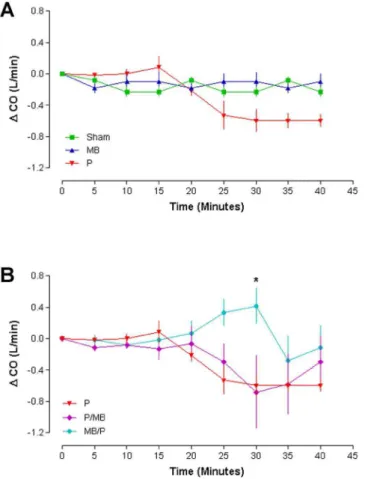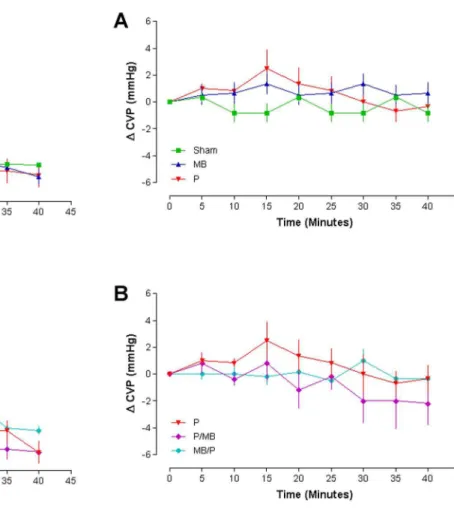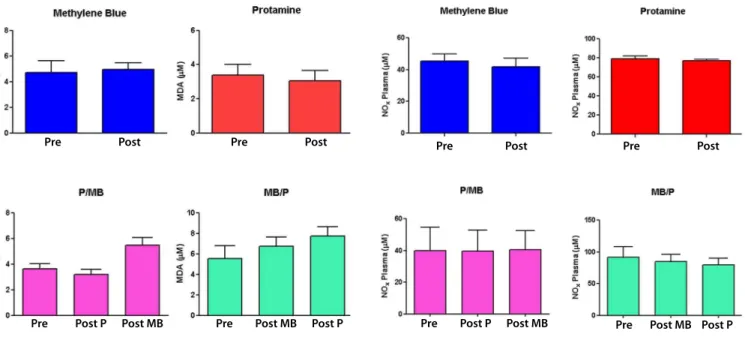Methylene Blue to Treat Protamine-induced
Anaphylaxis Reactions. An Experimental Study
in Pigs
Agnes Afrodite S. Albuquerque
1, BsC; Edson A. Margarido
1, MD; Antonio Carlos Menardi
1, MD, PhD; Adilson
Scorzoni Filho
1, MD; Andrea Carla Celotto
1, BsC, PhD; Alfredo J. Rodrigues
1, MD, PhD; Walter Vilella A. Vicente
1MD, PhD; Paulo Roberto B. Evora
1, MD, PhD
Abstract
Objective: To examine if methylene blue (MB) can counteract or prevent protamine (P) cardiovascular effects.
Methods: The protocol included five heparinized pig groups: Group Sham - without any drug; Group MB – MB 3 mg/kg infusion; Group P – protamine; Group P/MB – MB after protamine; Group MB/P – MB before protamine. Nitric oxide levels were obtained by the nitric oxide/ozone chemiluminescence method, performed using the Nitric Oxide Analizer 280i (Sievers, Boulder, CO, USA). Malondialdehyde plasma levels were estimated using the thiobarbiturate technique.
Results: 1) Groups Sham and MB presented unchanged parameters; 2) Group P – a) Intravenous protamine infusion caused mean arterial pressure decrease and recovery trend after 25-30 minutes, b) Cardiac output decreased and remained stable until the end of protamine injection, and c) Sustained systemic vascular resistance increased until the end of protamine injection; 3) Methylene blue infusion after protamine (Group P/MB) – a) Marked
mean arterial pressure decreased after protamine, but recovery after methylene blue injection, b) Cardiac output decreased after protamine infusion, recovering after methylene blue infusion, and c) Sustained systemic vascular resistance increased after protamine infusion and methylene blue injections; 4) Methylene blue infusion before protamine (Group MB/P) – a) Mean arterial pressure decrease was less severe with rapid recovery, b) After methylene blue, there was a progressive cardiac output increase up to protamine injection, when cardiac output decreased, and c) Sustained systemic vascular resistance decreased after protamine, followed by immediate Sustained systemic vascular resistance increase; 5) Plasma nitrite/nitrate and malondialdehyde values did not differ among the experimental groups.
Conclusion: Reviewing these experimental results and our clinical experience, we suggest methylene blue safely prevents and treats hemodynamic protamine complications, from the endothelium function point of view.
Keywords: Protamines. Nitric Oxide. Methylene Blue. Anaphylaxis.
Abbreviations, acronyms & symbols
CO CVP MAP MB MDA NO NOx PAP PCP PVR SEM SVR
= Cardiac output = Central venous pressure = Mean arterial pressure = Methylene blue = Malondialdehyde = Nitric oxide = Nitrite/nitrate
= Pulmonary arterial pressure = Pulmonary capillary pressure = Pulmonary vascular resistance = Standard error of the mean = Systemic vascular resistance
DOI: 10.5935/1678-9741.20160054
1Laboratory of Endothelium and Cardiovascular Function; Department of Surgery
and Anatomy, Faculdade de Medicina de Ribeirão Preto da Universidade de São Paulo (FMRP-USP), SP, Brazil.
This study was carried out at the Laboratory of Endothelium and Cardiovascular Function; Department of Surgery and Anatomy, Faculdade de Medicina de Ribeirão Preto da Universidade de São Paulo (FMRP-USP), SP, Brazil. No financial support.
No conflict of interest.
Correspondence Address: Paulo Roberto B. Evora
Faculdade de Medicina de Ribeirão Preto da Universidade de São Paulo Department of Surgery and Anatomy
Av. Bandeirantes, 3900 – Ribeirão Preto, SP, Brazil – Zip code: 14048-900 E-mail: prbevora@gmail.com
Article received on July 1st, 2016
Article accepted on July 30th, 2016
INTRODUCTION
protamine vasodilation. The first study reported in vitro systemic
and coronary vasodilation after protamine infusion[1]. The second
in vitro study suggested that pulmonary circulation is extensively involved in the protamine-mediated effects on endothelial
function[2]. The third study, carried out in anesthetized dogs,
reported the methylene blue (MB) and nitric oxide (NO) synthase blockers neutralization of the protamine vasodilatory
effects[3] The fourth study proposed that protamine also causes
endothelium-dependent vasodilation in heart microvessels and conductance arteries by different mechanisms, including
hyperpolarization[4]. Reviewing those experimental results and
our clinical experience, we suggest MB as a novel approach to prevent and treat hemodynamic complications caused by the
use of protamine after cardiopulmonary bypass[5].
In the absence of prospective clinical trials and cumulative clinical evidence, based on the literature case reports, the present study was carried out to examine if MB can counteract or prevent protamine cardiovascular effects.
METHODS
Experimental design
The protocol included five heparinized pig groups: Group Sham - without any drug; Group MB - MB 3 mg/kg infusion; Group P - protamine; Group P/MB - MB after protamine; Group MB/P - MB before protamine. NO plasma levels were measured in each of the experimental groups. The procedures and handling of the animals were reviewed and approved by the Institutional Animal Care review board (Reg 142/2006).
Animal preparation and hemodynamic parameters
Female Dalland pigs (22-26 kg) were induced to anesthesia with intramuscular administration of midazolam (15 mg/
kg, Dormid®, Cristália Produtos Químicos Ltda., SP, Brazil) and
tiletamine/zolazepam (10 mg/kg, Telazol®, Fort Dodge, IA, USA).
Maintenance was achieved by total intravenous anesthesia
using sufentanil (100 µg/h, Fastfan®, Cristália Produtos Químicos
Ltda., SP, Brazil) and propofol (10 mg/kg/h, Propovan®, Cristália
Produtos Químicos Ltda., SP, Brazil) delivered by syringe infusion pump (Syringe Infusion Pump, Harvard Apparatus, MA, USA).
Pancuronium bromide (6 mg/h, Pancuron®, Cristália Produtos
Químicos Ltda., SP, Brazil) was used as a muscle relaxant. Tracheostomy was performed on all animals immediately after induction of anesthesia. Volemia maintenance was achieved with intravenous infusion of sodium chloride 0.9% (5 mL/kg/h). A
Swan-Ganz CCOmbo CCO/SvO2 744HF75 (Edwards Lifesciences,
CA, USA) catheter was placed in the right jugular vein and into the lumen of the main pulmonary artery. The left carotid artery was simultaneously catheterized. Mean arterial pressure (MAP), pulmonary arterial pressure (PAP), pulmonary capillary pressure (PCP) and central venous pressure (CVP) were recorded by the MP System 100 A (BioPac System, Inc., CA, USA). Cardiac output (CO), systemic vascular resistance (SVR) and pulmonary vascular resistance (PVR) were obtained by the Vigilance System (Edwards Lifesciences LLC, CA, USA). After instrumentation, a period of 20 minutes was allowed for anesthesia stabilization. After that, hemodynamic parameters and clinical conditions were recorded for 15 minutes.
Statistical analysis
The hemodynamic results were expressed as mean ± standard error of the mean (SEM) and analysis of variance (Two-way ANOVA) and Bonferroni post-test. The Nitrite/Nitrate (NOx) and malondialdehyde (MDA) results were analyzed using paired T-test (Prism 5.0, GraphPad Software Inc., San Diego, CA, USA).
Values are considered to be statistically significant at P values
smaller than 0.05.
RESULTS
Mean arterial pressure (MAP)
Groups Sham, MB and P showed unchanged parameters. Intravenous P infusion caused MAP drop followed by a recovery trend after 25-30 minutes. The MAP curves of Sham, P and MB were not different and the effect was considered not quite
significant (P=0.05) (Figure 1A).
In the MB infusion before protamine group (Group MB/P), the drop in MAP was less severe, with rapid recovery. In MB infusion after protamine group (Group P/MB), marked MAP decrease after protamine was observed, with recovery after MB injection. The curves of P, P/MB and MB/P groups were not different and the
effect was not significant (P=0.3786) (Figure 1B).
Fig. 1 -Mean arterial pressure (n=6, Two-way ANOVA. Bonferroni post-test. P<0.05).
Cardiac output (CO)
Groups Sham, P and MB showed unchanged parameters
(n=6; P>0.05). The statistical significance was borderline and the
software pointed out that a larger number of animals would improve the data. In Group P, CO decreased and remained stable until the end of the protamine injection (Figure 2A).
In Group P/MB, CO decreased after protamine infusion, recovering after MB infusion. In the Protamine after MB group, there was a progressive CO increase to the time of protamine
injection, when CO decreased. In addition, the curves of P, P/
MB and MB/P were different and presented statistical difference
(P<0.05) between groups P and MB/P at 30 minutes (Figure 2B).
Systemic vascular resistance (SVR)
Groups Sham and MB showed unchanged parameters. Group P sustained an SVR increase until the end of the protamine injection. The SVR curves of Sham, P and MB were different and
presented statistical difference (P<0.01) between groups P and
Sham at 35 and 40 minutes (Figure 3A).
Group P/MB sustained SVR increase after P and MB injections and in Group MB/P, the SVR dropped after protamine followed by immediate SVR increase. Moreover, there was statistical
difference (P<0.05) between group P versus P/MB and P versus
MB/P at 40 minutes (Figure 3B).
Pulmonary arterial pressure (PAP)
The PAP curves in the Sham, P and MB groups showed
a statistically significant increase (P<0.001) after protamine
injection (15 minutes), followed by immediate decrease (Figure 4A). Also, the curves of Groups P, P/MB and MB/P showed
statistically significant difference (P<0.01) between Group P
versus P/MB and P versus MB/P at 15 minutes (Figure 4B).
Central venous pressure (CVP)
The CVP curves of Sham and MB remained stable during 40 minutes of experiment. On the other hand, Group P presented an increase at minute 15, followed by immediate decrease (Figure 5A). The curve in the MB/P group remained stable during 40 minutes of experiment and, P and P/MB presented an increase at minute 15, followed by immediate decrease (Figure 5B).
Plasma nitrite/nitrate (NOx)
Plasma NOx concentrations did not present statistically significant difference (Figure 6).
Fig. 2 - Cardiac output (n=6, Two-way ANOVA. Bonferroni post-test. P<0.05).
CO=cardiac output; MB=methylene blue; P=protamine
Fig. 3 - Systemic vascular resistance (n=6, Two-way ANOVA. Bonferroni post-test. P<0.05).
and surgical procedures, its reactions frequently led to severe
systemic hypotension, pulmonary hypertension, and shock[9-13].
Those consequences can be potentially dangerous, especially immediately after cardiopulmonary bypass, when intravascular volumes are not constant and cardiac function may be impaired.
Protamine can also cause hemodynamic disturbance
by means of anaphylactic reactions[6,14,15]. Indeed, Horrow[15]
classified protamine adverse reactions in three different categories: systemic hypotension, anaphylactoid reactions, and catastrophic pulmonary vasoconstriction.
The precise mechanism that explains protamine-mediated systemic hypotension is unknown. However, it is suggested that protamine decreases peripheral vascular resistance rather than
depressing myocardial function[9,11,16,17]. Protamine sulfate (either
as a free drug or complexed with heparin) binds to an unidentified endothelial cell receptor that mediates the conversion of L-arginine to NO. NO released abluminally activates soluble guanylate cyclase in the vascular smooth muscle to induce cyclic
Malondialdehyde (MDA)
MDA concentrations did not present statistically significant difference (Figure 7).
DISCUSSION
Heparin/protamine interaction is a topic of interest due to its use during cardiopulmonary bypass. These drugs are prescribed to more than 2,000,000 patients every year. From clinical and experimental data, heparin-neutralizing doses of protamine increase pulmonary artery pressures and decrease systemic blood pressure, myocardial oxygen consumption, CO, heart rate, and SVR. Those cardiovascular effects have clinical consequences that justified studies in this area.
Transitory hypotension in animals after protamine infusion
has been observed as an experimental effect for > 50 years[6-8].
However, until the development of cardiac surgery, protamine-induced hypotension was an experimental finding of little clinical relevance. As protamine became largely used in clinical Fig. 4 - Pulmonary arterial pressure (n=6, Two-way ANOVA. Bonferroni post-test. P<0.05).
PAP=pulmonary artery pressure; MB=methylene blue; P=protamine
Fig. 5 - Central venous pressure (n=6, Two-way ANOVA. Bonferroni post-test. P<0.05).
GMP (cGMP)-mediated relaxation (vasodilation). This results in a decrease in peripheral vascular resistance and hypotension. NO released luminally would promote thrombolysis and inhibit
platelet adhesion in the blood vessel[1]. Against this hypothesis,
it is important to report that Castresana et al.[17], using pig
vascular smooth muscle cell culture experiments, showed that protamine does not alter the responses of the intracellular second messengers, cGMP and cAMP, to the vasodilators sodium nitroprusside, atrial natriuretic peptide, isoproterenol, and forskolin. Those results do not support the hypothesis that protamine sensitizes vascular smooth muscle cells to the NO/ endothelium-derived relaxing factor. Favorable to the NO/ endothelium-dependent mechanism, MB has been successfully
used to reverse protamine vasoplegic reactions in humans[18-20].
For the endothelium-dependent vasodilatation in the pulmonary artery, a proposed mechanism suggests that protamine sulfate binds to an unidentified endothelial cell receptor to induce NO production from the amino acid L-arginine. NO then diffuses to the underlying vascular smooth muscle to induce relaxation (vasodilatation). NO released into the lumen would promote thombrolysis and inhibit platelet adhesion in the blood vessel. The conversion of L-arginine to NO can be inhibited by NG-monomethyl-L-arginine (L-NMMA), a methylated form of L-arginine. In addition, differently from the systemic circulation, heparin can inhibit the ability of protamine to induce NO, presumably by preventing the binding of
protamine to receptor[2]. Favorable to this hypothesis is the use
of inhaled NO to control pulmonary hypertension[21-23].
Plasma NOx and indirect free radical activity estimated by measuring MDA levels surprisingly did not show differences.
Pre Post Pre Post
Pre Post P Post MB Pre Post MB Post P
Fig. 6 - Plasma Nitrite/Nitrate (NOx) concentrations (n=6; t test. P<0.05).
Pre Post Pre Post
Pre Post P Post MB Pre Post MB Post P
Fig. 7 - Malondialdehyde concentrations (n = 6; t test. P<0.05).
Probably, the experimental time (40 minutes) was not enough for the laboratory techniques to detect the possible stimulus for NO release and free radical (lipidperoxidation) activity.
In conclusion, based on the results described, the following can be stated: 1) Individual MB infusion did not change MAP, CO and SVR values whereas MB injected before protamine attenuated the hypotension with rapid recovery and when injected after protamine, it reversed the marked hypotension; 2) CO decreased after protamine infusion, recovering after post-MB infusion, and MB infusion before protamine caused a progressive CO increase, followed by attenuation at the time of protamine injection; and 3) There was sustained SVR increase until the end of protamine injection, decreased SVR after protamine, followed by immediate SVR increase when MB was injected before protamine, and sustained SVR increase after protamine and post MB injections. Reviewing these experimental results and our clinical experience, we suggest that MB prevents and treats hemodynamic protamine complications.
Study limitations. It is mandatory to emphasize that the animals were not under cardiopulmonary bypass that causes systemic inflammatory reaction, since this reaction should exacerbate the hemodynamic effects of protamine. Other relevant limitation is the number of animals used for each group (n=6), except for borderline statistical significances, the statistical software pointed out that a larger number of animals would improve the data.
ACKNOWLEDGMENTS
Authors’ roles & responsibilities
AASA
EAM
ACM
ASF
ACC
AJR
WVAV
PRBE
Conception and study design; analysis and/or data interpretation; statistical analysis; manuscript writing or critical review of its content; final manuscript approval Conception and study design; analysis and/or data interpretation; final manuscript approval
Conception and study design; analysis and/or data interpretation; final manuscript approval
Conception and study design; analysis and/or data interpretation; final manuscript approval
Conception and study design; analysis and/or data interpretation; final manuscript approval
Conception and study design; analysis and/or data interpretation; final manuscript approval
Conception and study design; analysis and/or data interpretation; final manuscript approval
Conception and study design; analysis and/or data interpretation; statistical analysis; manuscript writing or critical review of its content; final manuscript approval
REFERENCES
1. Pearson PJ, Evora PR, Ayrancioglu K, Schaff HV. Protamine releases endothelium-derived relaxing factor from systemic arteries: a possible mechanism of hypotension during heparin neutralization. Circulation. 1992;86(1):289-94.
2. Evora PR, Pearson PJ, Schaff HV. Protamine induces endothelium-dependent vasodilation of the pulmonary artery. Ann Thorac Surg. 1995;60(2):405-10.
3. Raikar GV, Hisamochi K, Raikar BL, Schaff HV. Nitric oxide inhibition attenuates systemic hypotension produced by protamine. Thorac Cardiovasc Surg. 1996;111(6):1240-6.
4. Cable DG, Sorajja P, Oeltjen MR, Schaff HV. Different effects of protamine on canine coronary microvessel and conductance arteries: evidence of hyperpolarizing factor release. Surgery. 1999;126(5):835-41. 5. Viaro F, Dalio MB, Evora PR. Catastrophic cardiovascular adverse reactions
to protamine are nitric oxide/cyclic guanosine monophosphate dependent and endothelium mediated: should methylene blue be the treatment of choice? Chest. 2002;122(3):1061-6.
6. Marin-Neto JA, Sykes MK, Marin JL, Orchard C, Chakrabarti MK. Effect of heparin and protamine on left ventricular performance in the dog. Cardiovasc Res. 1979;13(5):254-9.
7. Jaques LB. A study of the toxicity of the protamine, salmine. Br J Pharmacol Chemother. 1949;4(2):135-44.
8. Jones MM, Hill AB, Nahrwold ML, Tait AR. Effect of protamine on plasma ionized calcium in the dog. Can Anaesth Soc. 1982;29(1):65-7. 9. Shapira N, Schaff HV, Piehler JM, White RD, Still JC, Pluth JR. Cardiovascular
effects of protamine sulfate in man. J Thorac Cardiovasc Surg. 1982;84(4):505-14.
10. Milne B, Rogers K, Cervenko F, Salerno T. The hemodynamic effects of intraaortic versus intravenous administration of protamine for reversal of heparin in man. Can Anaesth Soc J. 1983;30(4):347-51.
11. Frater RW, Oka Y, Hong Y, Tsubo T, Loubser PG, Masone R. Protamine-induced circulatory changes. J Thorac Cardiovasc Surg. 1984;87(5):687-92. 12. Wakefield TW, Hantler CB, Lindblad B, Whitehouse WM Jr, Stanley JC. Protamine pretreatment attenuation of hemodynamic and hematologic effects of heparin-protamine interaction. A prospective randomized study in human beings undergoing aortic reconstructive surgery. J Vasc Surg. 1986;3(6):885-9.
13. Stewart WJ, McSweeney SM, Kellett MA, Faxon DP, Ryan TJ. Increased risk of severe protamine reactions in NPH insulin-dependent diabetics undergoing cardiac catheterization. Circulation. 1984;70(5):788-92. 14. Kirklin JK, Chenoweth DE, Naftel DC, Blackstone EH, Kirklin JW, Bitran
DD, et al. Effects of protamine administration after cardiopulmonary bypass on complement, blood elements, and the hemodynamic state. Ann Thorac Surg. 1986;41(2):193-9.
15. Horrow JC. Protamine: a review of its toxicity. Anesth Analg. 1985;64(3):348-61.
16. Hines RL, Barash PG. Protamine: does it alter right ventricular function? Anesth Analg. 1986;65(12):1271-4.
17. Castresana MR, Zhang LM, Newman WH. Protamine does not affect the formation of cGMP or cAMP in pig vascular smooth muscle cells in response to vasodilators. Crit Care Med. 1995;23(5):939-43. 18. Panos A, Orrit X, Chevalley C, Kalangos A. Dramatic post-cardiotomy
outcome, due to severe anaphylactic reaction to protamine. Eur J Cardiothorac Surg. 2003;24(2):325-7.
19. Lutjen DL, Arndt KL. Methylene blue to treat vasoplegia due to a severe protamine reaction: a case report. AANA J. 2012;80(3):170-3. 20. Del Duca D, Sheth SS, Clarke AE, Lachapelle KJ, Ergina PL. Use of
methylene blue for catecholamine-refractory vasoplegia from protamine and aprotinin. Ann Thorac Surg. 2009;87(2):640-2.
21. Fettah ND, Dilli D, Cavusoglu H, Beken S, Ozgur S, Zenciroglu A, et al. Management of postoperative pulmonary hypertension by inhaled nitric oxide in a newborn with congenital diaphragmatic hernia. J Coll Physicians Surg Pak. 2014;24(9):690-1.
22. Kruzliak P, Maruyama J, Maruyama K. Role of nitric oxide in pathophysiology and treatment of pulmonary hypertension. Vitam Horm. 2014;96:407-24.



